|
|
|
23 September 08: Bridesburg to Betsy, or,
Yo holmes, to Delair!

That may be one of the worst headlines ever used on Philly Skyline. For that, I apologize. But for today's feature, to quote my recent Honey's Sit-n-Eat compatriot
Dice Raw (and his friend Talib Kweli on the hook), I will not apologize (I will not apologize).
We're back on that dynamic Delaware for the next stop, the double shot, the newest and the oldest bridges across that ocean-bound river in the city of Philadelphia:
Betsy Ross and Delair. It's true, that of the bridges spanning the Delaware River in Philadelphia, the oldest and the newest are right next to each other, closer
together than any of the bridges south of Trenton's trifecta and the Delaware Memorial twins.
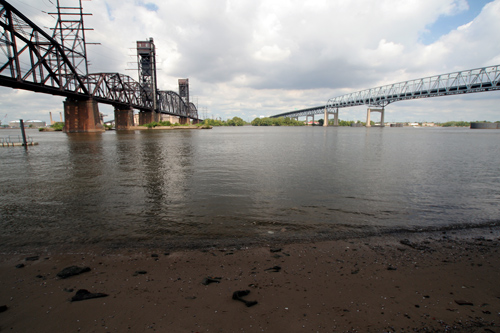
The Pennsylvania Railroad (PRR) ordered the construction of a bridge across the Delaware in 1895, the first ever crossing south of Trenton. The name Delair comes
from a section of Pennsauken Township, and to accommodate freight travel, a transfer was built here with the bridge, Delair Junction.
A railroad bridge directly across the Delaware was a sign of the powerful railroad times. It eliminated extra transfers of freight and it opened a direct line of
travel to the Jersey shore, including PRR's vacation community due east at Seaside Park and all points south -- Atlantic City, Ocean City and Cape May.
Trains departing from Broad Street Station would follow the main line to New York (modern day Northeast Corridor) and break from it toward Delair Bridge at
Frankford
Junction. The 'Shore' signal tower still exists, visible from the el on the right side between Tioga and Erie-Torresdale. Mike Brotzman's signalbox.com has a
feature on this tower HERE.
The engineering of the Delair Bridge is a landmark in tidal crossings not only for its sandy foundation and length -- only one bridge in the country had longer
truss spans in 1895 -- but also for the fact it was movable. (Historian Justin Spivey prepared a paper on Delair for the Library of Congress in 2001 with a thorough
background. It is online HERE.) Since the Delaware River is tidal,
vessels heading upstream needed clearance; since heavy trains would need support, a high bridge was far more expensive than a low, movable bridge, even for the PRR.
As such, a rotating swing truss was positioned in the channel for the passage of ships, and as with the other bridges we've covered so far, marine vehicles took
priority over rail vehicles, so the bridge was constantly manned to coordinate between the pilots of the ships and the trains.
This swing bridge sufficed . . . for a while. World War II really boosted naval technology, and that meant larger vessels, including civilian vessels. A little past
noon on January 9, 1959, the swing became outmoded. The SS Marie Leonhardt, an oceangoing ship carrying iron ore to the new Fairless Works steel facility in
Morrisville, struck the bridge when the operator did not open it in time. A full account is available from the subsequent lawsuit between the ship and PRR, tried in
1963 the Third Circuit Court of Appeals, online HERE.
The opening of Fairless Works also necessitated the deepening of the Delaware's channel; in 1959, the US Army Corps of Engineers moved the channel from the swing
one span to the west, where the existing span was replaced by a lift that would rise 135'. (The bridge's existing clearance was 50'.) In addition to the added
vertical clearance, the lift span provided far more horizontal clearance than the narrow swing did. To compare the before-and-after conditions, have a look at an
1896 photo of the Delair Bridge soon after its opening on workshopoftheworld.com HERE, and an aerial from 1964 after the completion of the lift, on phillyh2o.org HERE.
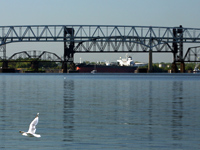 That lift bridge is in use today, same as it ever was. The photo at right (click to enlarge) shows the span lifted for the passing of a tanker heading toward Tioga
Terminal. The swing is no longer in use, but it's still there, making the Delair Bridge unique in that it has two movable spans in the same bridge.
That lift bridge is in use today, same as it ever was. The photo at right (click to enlarge) shows the span lifted for the passing of a tanker heading toward Tioga
Terminal. The swing is no longer in use, but it's still there, making the Delair Bridge unique in that it has two movable spans in the same bridge.
While the PRR is of course no longer around, a number of its ancestors, direct and indirect, certainly are. Conrail owns the Delair Bridge and leases its two
tracks: the northern one to New Jersey Transit for its 30th Street-Atlantic City line, the southern one to CSX and Norfolk Southern for freight travel.
New Jersey Transit's planned New York-Atlantic City express -- Atlantic City Express Service ("ACES" -- get it?) -- would also use the bridge in its route
from Penn Station to Atlantic City's terminal. The only stop it would make is in Newark; it only passes through Philly, switching off of the NEC line at Frankford
Junction. The transfer here is interesting: from NYC to Frankford, the train runs on an electric locomotive. From here to AC, it runs off of a diesel
locomotive. So, while there is an engine transfer, passengers will never have to leave the train. (They'll still have to go through Philly on an express route to AC
from NYC, but hey.)
As the passenger heads from Frankford toward the Delaware, out the left side of the train he will see a narrow body of water emptying into the river. It's the only
thing separating the Delair and Betsy Ross Bridges on the Philly side of the river. It wasn't always like this. Frankford Creek, which begins as Tookany Creek near
Arcadia University in Cheltenham and enters the city as Tacony Creek, where it continues through the park of the same name and the Juniata Golf Course on its way to
the Delaware as Frankford Creek in Bridesburg. (Makes sense, dunnit?) And while the trinomial trench has always deposited into the Delaware, it's only been
on the southern end of the neighborhood as long as the Betsy Ross Bridge.
In 1956, as part of a flood control project, Frankford Creek was rerouted from the northern end of Bridesburg to the southern end, the Bulletin calling it a
"snake that will be straightened." Adam Levine's excellent phillyh2o.org has a nice history (including a diagram printed by the Bulletin in 1949 of Creek pre- and
post-shift) HERE. Frankford Arsenal, on the north end of the former creek,
was originally called US Arsenal on Frankford Creek.
Around this same time, plans were being tossed around for a replacement to the aging, and low level, Tacony-Palmyra Bridge. And, as these were the 1950s, so too was
a vast network of expressways in and around Philly. The Crosstown (South Street) and Cobbs Creek Expressways are among the interstate designations (both I-695) that
fortunately never happened. A state route, the Pulaski Expressway (PA-90), would have followed Tacony/Frankford Creek, taking drivers from US-1, the Roosevelt
Expressway, to I-95 and the Delaware River at a new bridge, to be called -- like the existing railroad bridge -- the Delair Bridge. As always, Steve Anderson has a
thorough back story of the unbuilt Pulaski Highway at his web site phillyroads.com, HERE.
Meanwhile, I-95 was already under construction, and in 1969 one could travel from the new Scudder Falls bridge to Girard Avenue uninterrupted. Perhaps
unsurprisingly, both the Pulaski Expressway and the planned Delair Bridge were met with opponents in the neighborhoods they would affect. Protests from neighbors,
particularly along Adams Avenue, ultimately killed the Pulaski Expressway. With the Delair Bridge, though, residents of Bridesburg fearing an assault in traffic
simply delayed the construction, and then opening. Again, phillyroads.com has the historic overview HERE.
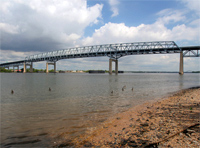 While the bridge was completed in 1974, it didn't actually open until 1976, by which time it had been renamed Betsy Ross Bridge, and during which year Bicentennial
pride and name association with (alleged) heroic flag seamstress Betsy Ross helped soften the blow of the bridge's opening in Bridesburg.
While the bridge was completed in 1974, it didn't actually open until 1976, by which time it had been renamed Betsy Ross Bridge, and during which year Bicentennial
pride and name association with (alleged) heroic flag seamstress Betsy Ross helped soften the blow of the bridge's opening in Bridesburg.
According to Steven Richman's The Bridges of New Jersey:
Opponents included Governor Milton Shapp of Pennsylvania and Mayor Frank L Rizzo of Philadelphia. On opening day, April 30, 1976, New Jersey Governor
Brendan Byrne faced about 150 demonstrators on the Pennsylvania side, who demanded barricades to protect Bridesburg.
Teresa Pyott, president of the Bridesburg Historical Society, recalls this with a laugh: "that was all really out of fear of traffic. But honestly, we all use it. I
think it's a wonderful bridge -- it drops me off in my neighborhood."
Of the delay in the opening, she tells a story: "Robert Hawthorne used to have a business down near the foot of the bridge, and he had a stable where he kept
horses. Before it opened, my daughter used to go riding with his kids across the bridge and ride along the shoreline in Jersey."
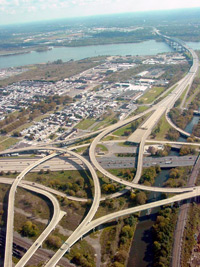 Just beyond that shoreline, the Betsy Ross Bridge deposited drivers onto US Route 130. In 1988, New Jersey built a connector road from the bridge to NJ-73,
effectively connecting Betsy Ross traffic with the Atlantic City Expressway, where 73 ends. That connector road has the designation NJ-90, a nod to PA-90, which was
never built. Actually, a small part of it was. When the ramps were finally built to the bridge in Bridesburg, so too were the beginnings of the ramps that would
carry drivers over I-95 to the Pulaski Expressway. Those humble(d) beginnings stand today, seen on the right side of 95 heading north under the Betsy Ross/Aramingo
interchange.
Just beyond that shoreline, the Betsy Ross Bridge deposited drivers onto US Route 130. In 1988, New Jersey built a connector road from the bridge to NJ-73,
effectively connecting Betsy Ross traffic with the Atlantic City Expressway, where 73 ends. That connector road has the designation NJ-90, a nod to PA-90, which was
never built. Actually, a small part of it was. When the ramps were finally built to the bridge in Bridesburg, so too were the beginnings of the ramps that would
carry drivers over I-95 to the Pulaski Expressway. Those humble(d) beginnings stand today, seen on the right side of 95 heading north under the Betsy Ross/Aramingo
interchange.
Under the operation of the Delaware River Port Authority, the Betsy Ross is, relatively
speaking, a lightly traveled bridge. Compared with the Ben Franklin (100,000) and Walt Whitman (150,000) bridges, the Betsy Ross' six lanes of traffic handle about
45,000 vehicles per day. The fare is the same for all three, though, $4, westbound only.
Of the four vehicular bridges across the Delaware in Philadelphia, the Betsy Ross is probably the easiest to access and easiest to drive. It's got a direct
connection to I-95, and there is rarely the congestion found on the Ben Franklin and Walt Whitman. And, it's the largest bridge in the country named for a woman.
Only a small railroad bridge in Iowa was existed with a woman's name prior to the opening of the Betsy Ross Bridge.
The Quaker Betsy Griscom eloped with the Episcopal John Ross, to avoid conflict within her church. They married in a tavern in Gloucester, and she became Betsy
Ross. To get there, they took the slow ferry from the old city down the river. If she'd only waited a couple hundred years, she could have fast-tracked across the
bridge bearing her name.
* * *
For a new mini-essay of photos of the Delair Bridge (18 total), please click
HERE.
For a new mini-essay of photos of the Betsy Ross Bridge (20 total), please click
HERE.
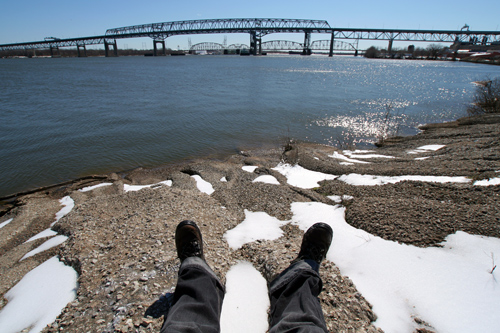
Winter of the Delaware: file photo from the Bridesburg banks of Philadelphia.
–B Love
|
SUMMER OF THE DELAWARE ARCHIVES:
|
|